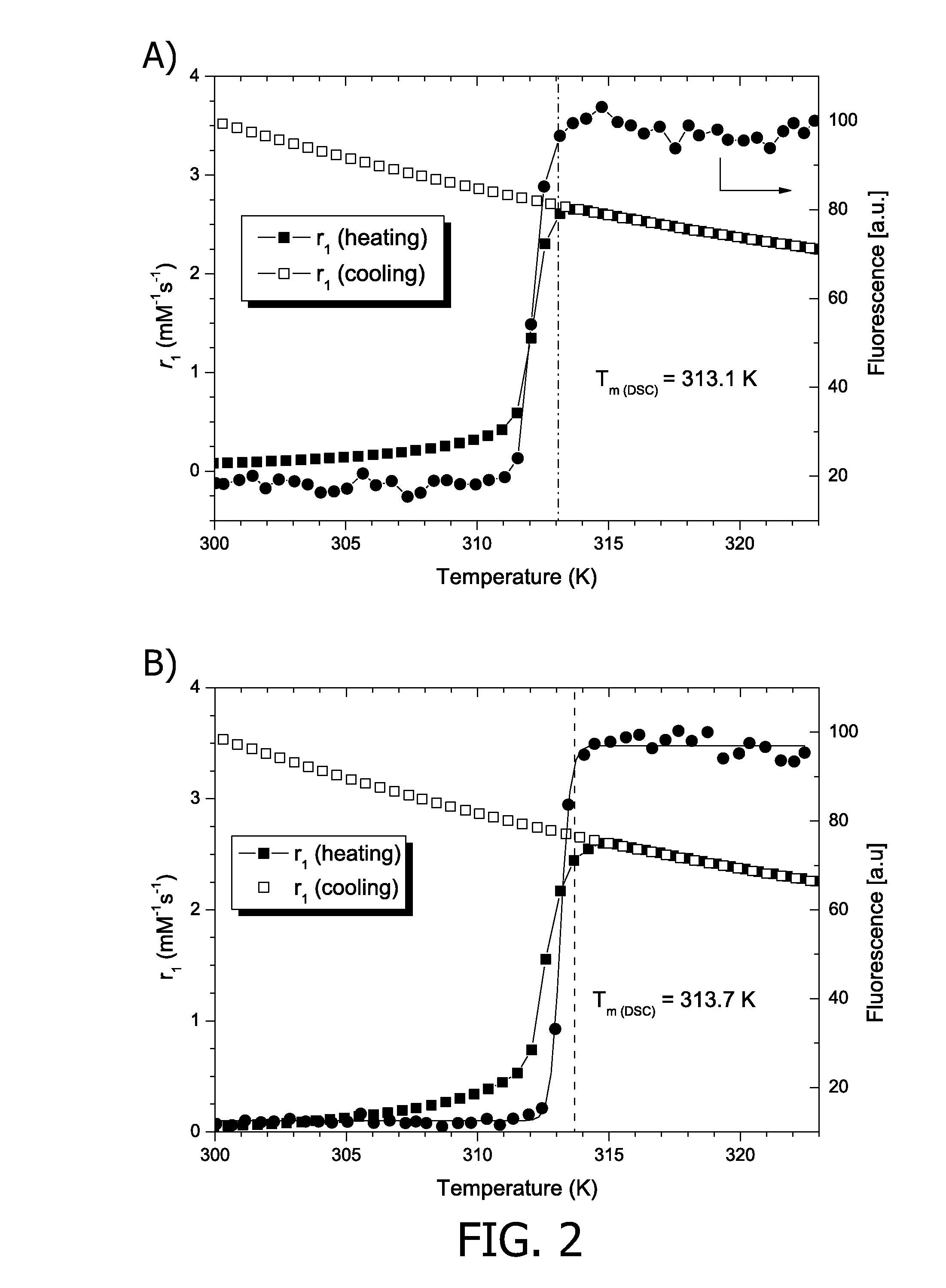Lipid bilayer carrier for drugs or imaging agents
a technology of lipid bilayer carrier and imaging agent, which is applied in the direction of dispersed delivery, diagnostics, diagnostic recording/measure, etc., can solve the problems of not being able to provide thermosensitive liposomes that meet the current demands for use in modern imaging and therapy applications, and significant side effects for patients
- Summary
- Abstract
- Description
- Claims
- Application Information
AI Technical Summary
Benefits of technology
Problems solved by technology
Method used
Image
Examples
examples and drawings
[0126]The invention will be illustrated with reference to the following, non-limiting examples and the accompanying non-limiting drawings (FIGS. 1-7).
DESCRIPTION OF THE DRAWINGS
[0127]FIG. 1 presents a bar diagram showing the melting phase transition temperatures of temperature sensitive liposomes (TSLs) containing either 10 mol % of Lyso-PC or 10 mol % of 1n,R in the lipid bilayer and 250 mM ProHance and doxorubicin in their aqueous lumen.
[0128]FIG. 2 shows fluorescence and longitudinal relaxivity results for TSLs containing 10 mol % acetylated PCs (1n,R: n=0, R=C15H31 or C17H35) in the lipid bilayer and 250 mM ProHance and doxorubicin in their aqueous lumen.
[0129]Depicted are the fluorescence and longitudinal relaxivity during a linear temperature increase (0.5 K / min) from 300 K to 323 K for LTSLs containing. 10,R (R=C15H31, top left) and 10,R (R=C17H35, top right) in HBS. The release of doxorubicin as a function of temperature for LTSLs containing: 10,R (R=C15H31, bottom left) and...
example 1
[0137]A compound of the above-identified type 1n,R having n=0, and R=C17H35, i.e. 1(n=0, R=C17H35), was prepared as follows. A solution of 4-dimethylaminopyridine (149.1 mg, 1.22 mmol) in dichloromethane (8 mL) dried on molecular sieves was added to 1-myristoyl-2-stearoyl-sn-glycero-3-phosphocholine, abbreviated as MSPC (211.8 mg, 0.404 mmol). Subsequently, acetic anhydride (115 μL, 1.23 mmol) was added and the mixture was stirred for 30 hours at room temperature under nitrogen atmosphere to yield a colorless solution. Methanol (8 mL) was added and the solvent was removed at room temperature under reduced pressure. The crude mixture was dissolved in chloroform (8 mL) and the organic layer was extracted three times with a solution of MeOH (8 mL) and 0.1 M HCl (8 mL). The mixture was centrifuged (30 minutes, 4000 rpm) to induce fast phase separation. The remaining organic layer was filtered, and then concentrated on a rotary evaporator at room temperature under reduced pressure. The c...
example 2
[0138]The compound 1(n=3, R=C17H35) was obtained similar to 1(n=0, R=C17H35) of Example 1, in 70% yield (0.172 g) Instead of acetic anhydride, valeric anhydride (240 μL, 1.22 mmol) was used. This product did not dissolve completely in acetone therefore purification was done by stirring the crude product in acetone before cooling to −20° C. The product was analyzed using 1H- and 13C NMR spectroscopy.
PUM
 Login to View More
Login to View More Abstract
Description
Claims
Application Information
 Login to View More
Login to View More - R&D
- Intellectual Property
- Life Sciences
- Materials
- Tech Scout
- Unparalleled Data Quality
- Higher Quality Content
- 60% Fewer Hallucinations
Browse by: Latest US Patents, China's latest patents, Technical Efficacy Thesaurus, Application Domain, Technology Topic, Popular Technical Reports.
© 2025 PatSnap. All rights reserved.Legal|Privacy policy|Modern Slavery Act Transparency Statement|Sitemap|About US| Contact US: help@patsnap.com



